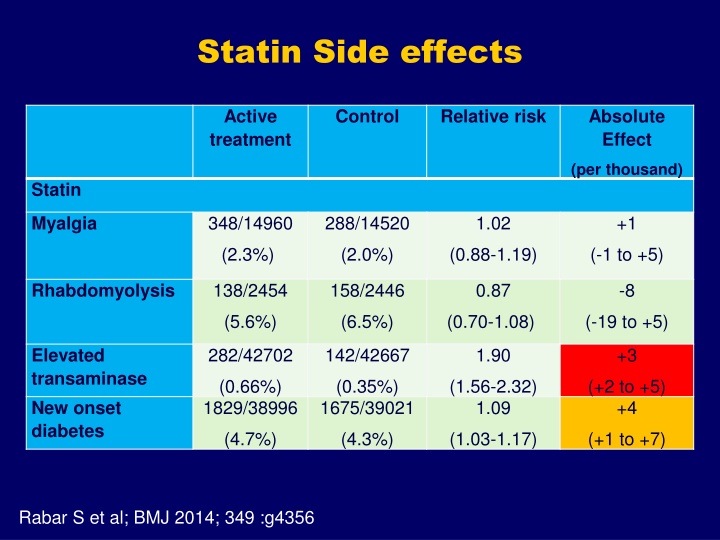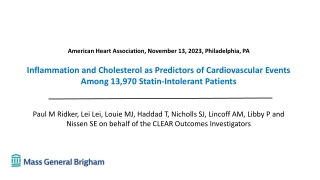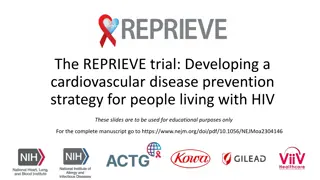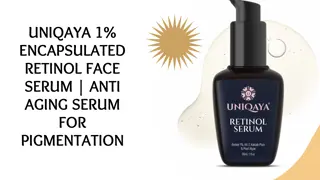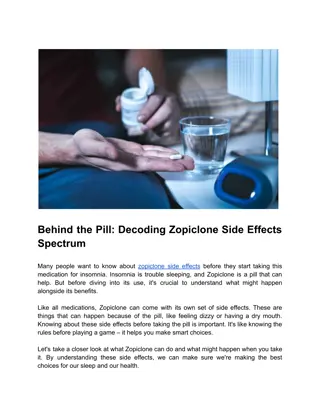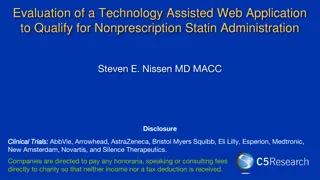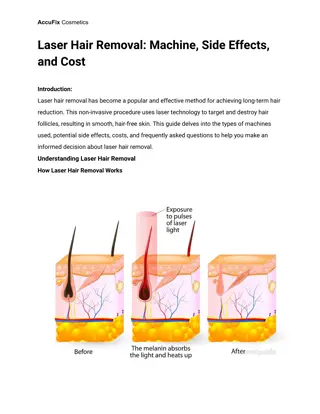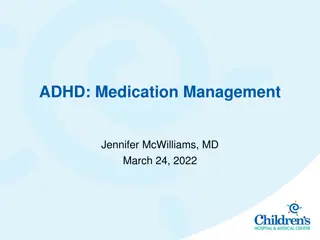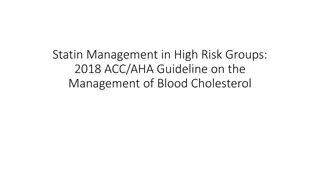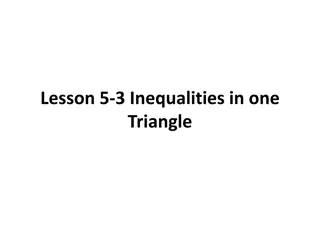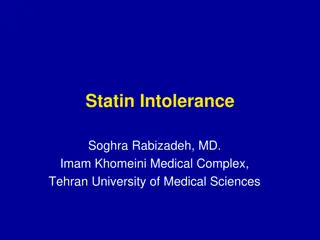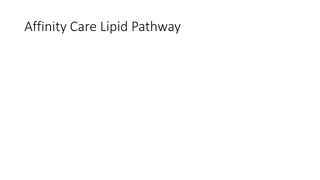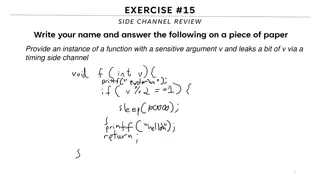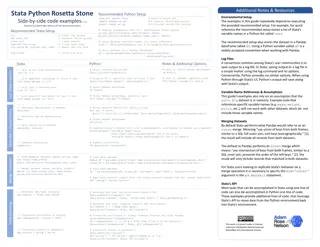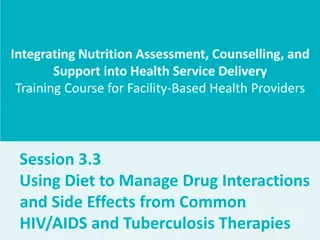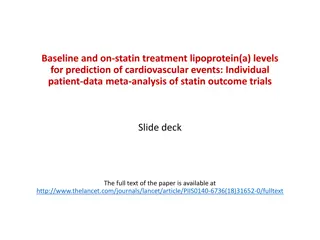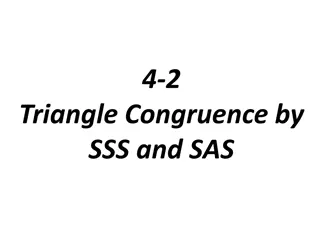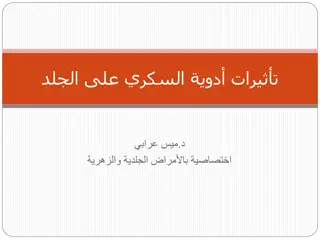Statin Side effects
This text discusses the side effects of statins such as myalgia and rhabdomyolysis, as well as the risk of new-onset diabetes associated with statin use. It also explores the effects of ATP-citrate lyase and bempedoic acid, along with PSCK-9 inhibitors on LDL-C and apoB levels. The study highlights hazard ratios, relative risks, absolute effects, and control measures related to statin therapy.
Download Presentation

Please find below an Image/Link to download the presentation.
The content on the website is provided AS IS for your information and personal use only. It may not be sold, licensed, or shared on other websites without obtaining consent from the author.If you encounter any issues during the download, it is possible that the publisher has removed the file from their server.
You are allowed to download the files provided on this website for personal or commercial use, subject to the condition that they are used lawfully. All files are the property of their respective owners.
The content on the website is provided AS IS for your information and personal use only. It may not be sold, licensed, or shared on other websites without obtaining consent from the author.
E N D
Presentation Transcript
Statin Side effects Active treatment Control Relative risk Absolute Effect (per thousand) Statin 348/14960 288/14520 1.02 +1 Myalgia (2.3%) (2.0%) (0.88-1.19) (-1 to +5) 138/2454 158/2446 0.87 -8 Rhabdomyolysis (5.6%) (6.5%) (0.70-1.08) (-19 to +5) 282/42702 142/42667 1.90 +3 Elevated transaminase New onset diabetes (0.66%) 1829/38996 (0.35%) 1675/39021 (1.56-2.32) 1.09 (+2 to +5) +4 (4.7%) (4.3%) (1.03-1.17) (+1 to +7) Rabar S et al; BMJ 2014; 349 :g4356
New onset diabetes with statins Study Hazard ratio (95% CI) for new-onset diabetes TNT 2.53 [2.34, 2.73] P value Risk factors Fasting glucose per 10 mg/dl increase <0.0001 IDEAL TNT IDEAL TNT 2.49 [2.26, 2.74] 1.21 [1.16, 1.26] 1.29 [1.20, 1.38] 1.15 [1.06, 1.24] <0.0001 <0.0001 <0.0001 0.0012 BMI per 3 kg/m2increase Natural log [WBC] per 0.25 log (103/mm3) increase Natural log [triglyceride] per 1.0 log (mg/dl) increase TNT 1.85 [1.53, 2.22] <0.0001 IDEAL TNT IDEAL TNT IDEAL 1.48 [1.19, 1.83] 1.24 [1.05, 1.46] 1.32 [1.09, 1.60] 1.10 [0.94, 1.29] 1.19 [0.98, 1.43] 0.0004 0.0098 0.005 0.226 0.075 Hypertension Effect of atorvastatin 80 mg Rabar S et al; BMJ 2014 & Waters DD et al. J Am Coll Cardiol. 2011; 57 :1535
Statin discontinuation - consequences Neilsen SF & Nordestgaard BG. Eur Heart J 2016; 37 : 908
Steps Involved in Cholesterol Absorption Dietary Cholesterol Biliary Cholesterol Intestinal Epithelial Cell Sitosterol CM X Cholesterol Esters Luminal Cholesterol ABC-G5 ACAT ABC-G8 Bile Acids Micellar Cholesterol NPC1L1 Transporter Cholesterol X Sitostanol Ezetimibe
IMPROVE IT : Ezetimibe in statin-treated ACS Lipids Events 20 10 1.35 P=0.01 2.46 (1.80) P=0.002 4.20 1.10 p=0.95 Change (%) 0 -10 Final 1.40 -20 p=0.01 -30 Secondary prevention; n= 18144 NNT including PCI = 50 Cannon CP et al ; NEJM 2015; 372 : 2387 Effects larger in elderly & Type 2 DM
ATP-citrate lyase & bempedoic acid Pinkosky SL et al. Nature Comm 2016; 7: 13457 Da Minno A et al. J Am Heart Assoc 2020;9:e016262
Effects of PSCK-9 inhibition on LDL-C & apoB PSCK-9 inhibitors Small molecule Pre-clinical only Antibody Alirocumab; Evolocumab: Bococizumab- discontinued Antisense oligonucleotide SPC-5001- discontinued Targeted siRNA inclisiran Stein EA et al; Lancet 2012; 380 : 29 Ray KK et al; NEJM 2017: 376: 1430 Inclisiran- 2 injections
PCSK-9 inhibition-Evolocumab: FOURIER- ACS & GLAGOV-IVUS 95th centile 50th centile 0.5 1.0 1.5 2.0 2.5 LDL-C on treatment (mmol/L) Sabatine M et al; NEJM 2017; 376: 1713 Nicholls SJ et al. JAMA 2016; 316: 2373
Other LDL-C lowering drugs: ezetimibe & PCSK9 inhibitors Active Treatment Control Relative Risk Absolute Effect (Events/1000) (7 years) Ezetimibe (IMPROVE-IT) CVD Mortality 617/9424 (6.5%) 1191/9424 (12.6%) 383/9424 (4.1%) (1.1-2.2 years) 627/9440 (6.7%) 1345/9440 (14.8%) 437/9440 (4.8%) 0.99 Nil (0.89-1.10) 0.90 (0.84-0.97) 0.88 (0.77-1.01) -7 to +7 -15 (-4 to -24) -6 (-11 to Zero) Non-Fatal MI Stroke PCSK-9 555/36968 (1.5%) 1256/36968 (3.4%) 363/36968 (1.0%) 576/36964 (1.6%) 1571/36964 (4.3%) 489/36964 (1.3%) 0.96 Nil CVD Mortality (0.80-1.20) 0.80 (0.62-0.88) 0.74 (0.34-1.04) (-2 to +4) -9 (-8 to -16) -3 (-6 to +1) Non-Fatal MI Stroke Wierzbicki AS et al; Curr Op Cardiol 2018; 33 : 416
Guidelines for PCSK-9 inhibitors Alirocumab Evolocumab Inclisiran (TA393) (2016) FH, T2DM, CVD, statin intolerance (TA394) (2016) FH, T2DM, CVD. Statin intolerance (TA733) (2021) FH, T2DM, CVD Surrogate (lipid) outcomes (ODYSSEY programme) ODYSSEY-Outcomes (Scientists names programme) FOURIER (Orion programme) Under way CVD outcomes study NICE recommendations Add-on to maximal tolerated therapy Coronary artery disease/single vascular bed Dual vascular bed LDL-C >3.5mmol/L LDL-C >4mmol/L LDL-C >4mmol/L CVD event & LDL-C > 2.6mmol/L LDL-C >3.5mmol/L CVD event & LDL-C > 2.6mmol/L Not recommended LDL-C >5.0mmol/L LDL-C >5.0mmol/L Familial hypercholesterolaemia (primary prevention) Not recommended Not recommended Not recommended Primary prevention (common causes) www. NICE.org.uk
Other secondary Drug Interventions Bile acid sequestrants Weak monotherapy evidence on CVD No combination evidence with statins Do not use Fibrates Meta-analysis: moderate monotherapy benefit Meta-analysis: No combination therapy benefit No routine use ( i.e. 2nd/3rd line) Omega-3 Fatty acids Mixed diet and supplement trials. Multiple supplement trials used Meta-analysis: no combination therapy benefit (low dose) Under NICE HTA review (REDUCE-IT vs STRENGTH)
Fibrates : meta-analyses Secondary& primary prevention; 10 &18 studies; n= 36489 & 45,058 Lipids Events p=0.92 P=0.69 P<0.001P=0.05 Change (%) Active treatment Control Relative risk Absolute Effect Fibrates CVD mortality 704/21886 1032/23536 0.92 -4 (3.2%) 1104/21896 (4.4%) 1574/23549 (0.81-1.04) 0.80 (-8 to +2) -13 Non-fatal MI (5.0%) 610/20784 (6.7%) 772/22404 (0.74-0.87) 1.01 (-9 to -17) Zero Stroke (2.9%) (3.5%) (0.90-1.13) (-4 to +5) Saha S et al; Am Heart J 2007; 154: 943 Jun M et al; Lancet 2010 ; 375 : 1875
Drugs affecting inflammation & CVD Indirect effects Statin Rho kinase activity Fibrate PPAR effects Omega-3 fatty acid FFAR-4 (GPR120) Thiazolidinedione 2o Fibrate effect BET inhibitors Apabetalone Direct effects ACAT inhibitors (macrophage) Avasimibe ; Pactimibe VCAM-1 uncouplers Probucol; AGI-1067 PLA2 inhibitors Daraplabib (LpPLA2) ; Varespladib (sPLA2) IL-1 inhibitors Canakinumab Microtubule inhibitors Colchicine
Mechanism of omega-3 FA receptor- FFA-4/GP120 Ulven T & Christiansen E; Ann Rev Nutr 2015; 35 : 239
Omega-3 fatty acid trials 70 MI CVA CVD 60 Mortality AF 50 40 Relatibe risk (%) 30 20 10 0 <1g JELIS 2g REDUCE-IT 4g STRENGTH 4g -10 -20 -30 Aung T et al. JAMA Cardiol 2018; 3 : 225 Bhatt D et al. NEJM 2019; 390 : 12 Nicholls SJ et al; JAMA 2020;
Lipid monitoring LFTs Check transaminase after 3 months then yearly No need for CK unless symptomatic Do not offer statin if CK >1000iu/L (5 x ULN) Check glucose if new on statin and high risk for DM. Do not stop statin therapy if glucose increases. Check adherence etc if non-HDL-C response <40% Statin intolerance Any dose statin reduces CVD Reduce dose; switch intensity class; consult specialist
Guidelines: Defining recommendations Targets Drug-based Consistent with epidemiology Rare in clinical trials Traditional output Focused on single risk factor Set on 50th centile Requires multiple monitoring Consistent with trials Exception limits defined Common trial design Novel output Focused on overall risk Centile-independent Minimal monitoring required
NICE CG 181 Continuum of CVD Risk and its treatment Acute coronary syndrome (ACS) Atorva 80mg (+ Eze 10mg then PCSK9 Post MI/Angina Atorva 80mg (+ Eze 10mg) Secondary Prevention Other Atherosclerotic Manifestations Atorva 80mg Subclinical Atherosclerosis: Type 2 diabetes Atorva 20-40mg Primary Prevention Lifestyle then Atorva 20mg Multiple RFs QRISK>10% Low Risk Lifestyle Courtesy of CD Furberg.; modified to include NICE CG181
Primary Prevention: Medicines Optimisation for Lipid Management Lifestyle change and dietary measures are key to CVD event reduction together with drug therapy In primary care check: non-fasting lipid profile: TC, TG, HDL-C, LDL-C, non-HDL-C; liver function (LFTs), HbA1c, TSH & renal function, blood pressure (BP), weight, smoking status and calculate QRisk2 score (www.qrisk.org) Other CVD risk factors, if present,: Severe obesity (BMI >40kg/m2), socio-economic status, human immunodeficiency virus (HIV) treatment, severe mental illness, autoimmune disease (RA or SLE) medications that may cause dyslipidaemia, impaired fasting glycaemia QRisk3 does not apply in : FH, type 1 diabetes (T1DM) CKD 3- high CVD risk and need a high intensity statin. Offer HI statin to patients with Type 1 DM and age >40 years or DM >10 years or nephropathy or other CVD risk factorsNI Consider options with shareddecision making , education and lifestyle interventions to modify CVD risk. Consider the risk:benefit of therapy holistically: e.g. patients aged 85years consider frailty, life expectancy and co-morbidities Optimise management of BP and other co-morbidities. Support lifestyle interventions and medicines adherence. If QRisk 10%: consider moderate dose of a high intensity drug atorvastatin 20mg (or rosuvastatin 10mg) daily Step 1 in primary care: Consider up-titration to maximum dose atorvastatin 80mg (alternative is rosuvastatin 20-40mg After 3 months, has non-HDL cholesterol fallen by 40% from baseline? Check adherence to medication, timing of dose, statin adverse effects/intolerance/hesitancy & diet/lifestyle Step 2: If intolerant to higher dose of statin, consider adding ezetimibe 10mg daily After 3 months, has non-HDL cholesterol fallen by 40% from baseline? Check adherence , adverse effects Step 3 : If intolerant to any statin, start ezetimibe 10mg daily, consider adding bempedoic acid 180mg daily Review annually for adherence to medications, diet and lifestyle, check required bloods eg lipids. Refer for support as required from specialist teams. Refer to lipid clinic
Secondary Prevention: Medicines optimisation for Lipid Management 1) Check baseline bloods (non-fasting lipid profile, LFTs, HbA1c, thyroid and renal function) 2) Offerhigh dose high intensity statin: atorvastatin 40-80mg (or rosuvastatin 20-40mg) to adults with CVD: acute coronary syndromes (ACS), angina, myocardial infarction (MI), revascularisation, stroke or TIA, peripheral arterial disease or abdominal aortic aneurysm (AAA) 3) Support self-management e.g. smoking, diet, obesity, alcohol intake, activity, blood pressure & glycaemic control (HbA1c) In primary care check: Is patient on high dose, high intensity statin? atorvastatin 40-80mg (alternative is rosuvastatin 20mg-40mg) Has non-HDL-C reduced> 40% from baseline at 3 months? if no baseline : target nHDL-C <2.5mmol/L or LDL-C <2.0mmo/L Discuss statin choice: check adherence-After 3 months check non-fasting lipid profile (TC, TG, HDL, LDL-C); LFTs Has non-HDL-C reduced >40% from baseline at 3 months?If no baseline: target nHDL-C < 2.5mmol/L or LDL-C <2.0mmol/L). Check adherence Consider adding Ezetimibe 10mg daily S After 3 months, check non-fasting lipid profile (TC, TG, HDL, LDL-C); LFTs Has non-HDL-C reduced >40% from baseline at 3 months? (if no baseline: target nonHDL-C <2.5mmol/L or LDL-C <2.0mmo/L Following a review of adherence/adverse effects/intolerance/hesitancy and lifestyle interventions Consider inclisiran initiation in primary care if LDL 2.6 mmol/L following advice from a specialist Refer to lipid clinic if statin intolerance: lipid clinic will consider addition of bempedoic acid to ezetimibe or inclisiran Refer to lipid clinic if LDL-C >4mmol/L (or LDL-C >3.5mmol/L with recurrent CVD event or multivascular disease) to consider PCSK9 antibody Review annually for adherence to medications, support diet and lifestyle, and check required bloods eg lipid profile, LFTs
Explaining the fall in coronary heart disease deaths in England & Wales 1981-2000 Risk Factors worse +13% Obesity (increase) +3.5% Diabetes (increase) +4.8% Physical activity (less) +4.4% 0 Risk Factors better -71% Smoking Cholesterol Population BP fall -9% Deprivation -3% Other factors -8% -20000 -41% -9% -40000 Treatments -42% AMI treatments Secondary prevention -11% Heart failure Angina:CABG & PTCA -4% Angina: Aspirin etc -5% Hypertension therapies -3% -8% 68,230 fewer deaths in 2000 -60000 -12% -80000 1981 2000 Unal, Critchley & Capewell Circulation 2004 109(9) 1101
